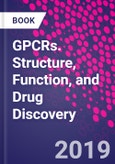GPCRS: Structure, Function, and Drug Discovery provides a comprehensive overview of recent discoveries and our current understanding of GPCR structure, signaling, physiology, pharmacology and methods of study. In addition to the fundamental aspects of GPCR function and dynamics, international experts discuss crystal structures, GPCR complexes with partner proteins, GPCR allosteric modulation, biased signaling through protein partners, deorphanization of GPCRs, and novel GPCR-targeting ligands that could lead to the development of new therapeutics against human diseases. GPCR association with, and possible therapeutic pathways for, retinal degenerative diseases, Alzheimer's disease, Parkinson's disease, cancer and diabetic nephropathy, among other illnesses, are examined in-depth.
Please Note: This is an On Demand product, delivery may take up to 11 working days after payment has been received.
Table of Contents
Part I GPCR structure 1. Progress in GPCR structure Determination 2. Structure, function and therapeutic potential of adhesion GPCRs 3. Structural diversity in ligand recognition by GPCRs 4. NMR-based approaches to the study of GPCRs and GPCR-ligand interactions 5. Supramolecular structure of opsins 6. Molecular determinants of GPCR oligomerization 7. Structure of G-protein-coupled receptor heteromers 8. Class A GPCR oligomerization: reasons of controversy
Part II GPCR function 9. Quantifying GPCR allostery and biased signaling 10. Kinetics of ligand binding and signaling 11. Allosteric modulators targeting GPCRs 12. Arrestin-mediated signaling at GPCRs 13. Organellar Gb? signaling GPCR signaling beyond the cell surface
Part III GPCRs in disease and targeted drug discovery 14. G protein-coupled receptor allosteric modulators: understanding modulator affinity and pharmacological dose 15. Computer-aided GPCR drug discovery 16. Tackling the complexities of orphan GPCR ligand discovery with rationally assisted approaches 17. G protein-coupled receptors in neurodegenerative diseases 18. GPCR targets in type 2 diabetes 19. GPCRs in thromboinflammation and hemostasis 20. Angiotensin II receptors: structure-function and drug discovery 21. GPCRs in innate and adaptive immune responses 22. Role of GPCRs in cancer
Authors
Beata Jastrzebska Assistant Professor, Department of Pharmacology, School of Medicine, Case Western Reserve University, OH, USA. Dr. Beata Jastrzebska is an Assistant Professor in the Department of Pharmacology, School of Medicine, Case Western Reserve University, Ohio. Her lab focuses on understanding the structure and function of the visual G protein coupled receptor (GPCR), rhodopsin. In particular, she is interested in delineating the rhodopsin supramolecular organization and its implications for binding with the cognate heterotrimeric G protein, transducin. Several mutations identified in the rhodopsin gene leading to the retinal degeneration in humans, such as retinitis pigmentosa (RP), could affect membrane oligomeric organization of this receptor. Therefore, efforts are directed towards understanding the molecular basis of rhodopsin gene associated retinal degradation in humans using biochemical, biophysical, and structural methods. Dr. Jastrzebska has published her research widely in peer reviewed journals and serials, including Biochemistry, Methods in Molecular Biology, JACS, and Methods in Enzymology. Paul S.-H. Park Associate Professor, Principle Investigator, Department of Ophthalmology and Visual Sciences, Case Western Reserve University, OH, USA. Dr. Park is an Associate Professor at the Department of Ophthalmology and Visual Sciences,Case Western Reserve University, Ohio. He serves as Principle Investigator at the Park Lab, which focuses on molecular mechanisms underlying phototransduction and the determinants of photoreceptor cell health in the retina. Dr. Park and his team use advanced microscopy and spectroscopy methods in combination with more traditional biochemistry, microscopy, and cell biology methods. Dr. Park has published his research widely in peer reviewed journals, including Biochemistry, the Journal of Biological Chemistry, the Journal of Cell Biology, the Journal of Molecular Biology, and the European Journal of Pharmacology








